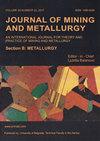含挥发物的结晶器助焊剂半球面点温度不确定性问题的表征与分析
IF 1
4区 材料科学
Q3 METALLURGY & METALLURGICAL ENGINEERING
Journal of Mining and Metallurgy Section B-Metallurgy
Pub Date : 2022-01-01
DOI:10.2298/jmmb211209019w
引用次数: 0
摘要
在连铸结晶器半点温度(Thp)测量中,挥发物在高温下的蒸发会对结果产生强烈的影响。在综合分析半球点法及其影响因素的基础上,选择相应的含挥发型助焊剂和不含挥发型助焊剂,得到不同加热速率下的Thp。结合Thp测量和TG-DSC结果,分析了测量过程中相关因素的影响,并提出了表征和评价影响的方法。在此基础上,提出了一种改进的助熔剂熔点测试方法。结果表明,对于非挥发型助熔剂,温度滞后比传热延迟和分次熔炼的影响更大。而对于具有挥发性的助焊剂,蒸发的影响大于其他因素。传统的半点法已不再适用于挥发型焊剂。为了解决这一问题,提出了改进的方法。一种是用传统方法测量Thp,在Thp处修正成分,用修正后的成分对应Thp。另一种是取初始成分,修正半球面点温度Thp,将修正后的Thp与初始成分进行匹配。本文章由计算机程序翻译,如有差异,请以英文原文为准。
Characterization and analysis on the hemispherical point temperature uncertainty problem of mold flux with volatiles
In hemisphere point temperature (Thp) measurement of continuous casting mold flux, the evaporation of volatiles under high temperature will have a strong impact on the results. Based on the comprehensive analysis of hemisphere point method and its influencing factors, the corresponding volatile-containing mold flux and non-volatile mold flux were selected to get Thp with different heating rates. Combined with the Thp measurement and TG-DSC results, the effect of relevant factors during measuring process were analysed and the way to characterize and evaluate the effects were suggested. Furthermore, an improved method of mold flux melting point test was put forward. The results showed that for non-volatile mold flux, the temperature hysteresis has a greater effect than heat transfer delay and fractional melting. And for mold flux with volatile, the effect of evaporation is greater than other factors. Traditional hemisphere-point method is no longer suitable for the volatile mold flux. In order to get through this problem, improved methods were proposed. One is measuring Thp by traditional way, correcting the composition at the Thp, corresponding Thp with the corrected composition. Another is taking the initial composition, revising the hemispherical point temperature Thp, matching the revised Thp with the initial composition.
求助全文
通过发布文献求助,成功后即可免费获取论文全文。
去求助
来源期刊
CiteScore
2.00
自引率
40.00%
发文量
19
审稿时长
2 months
期刊介绍:
University of Belgrade, Technical Faculty in Bor, has been publishing the journal called Journal of Mining and Metallurgy since 1965 and in 1997 it was divided in two independent journals dealing with mining and metallurgy separately. Since 2009 Journal of Mining and Metallurgy, Section B: Metallurgy has been accepted in Science Citation Index Expanded.
Journal of Mining and Metallurgy, Section B: Metallurgy presents an international medium for the publication of contributions on original research which reflect the new progresses in theory and practice of metallurgy. The Journal covers the latest research in all aspects of metallurgy including hydrometallurgy, pyrometallurgy, electrometallurgy, transport phenomena, process control, solidification, mechanical working, solid state reactions, materials processing, surface treatment and relationships among processing, structure, and properties of materials.

 求助内容:
求助内容: 应助结果提醒方式:
应助结果提醒方式:


